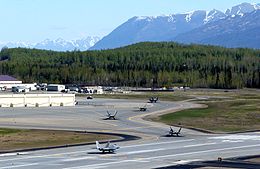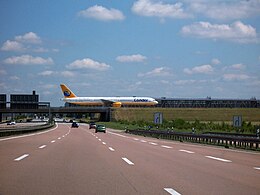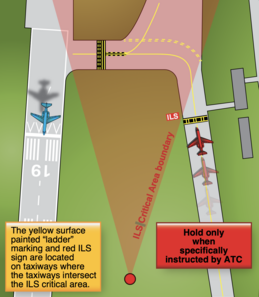79:
518:
372:
506:
325:
530:
35:
68:
46:
293:
494:
474:, unidirectional, steady-burning in-pavement lights installed across the entire taxiway at the runway holding position, and elevated steady-burning red lights on each side used in low visibility conditions (below 1,200 ft RVR). A controlled stop bar is operated in conjunction with the taxiway centerline lead-on lights which extend from the stop bar toward the runway. Following the ATC clearance to proceed, the stop bar is turned off and the lead-on lights are turned on.
305:
281:
57:
20:
482:
733:
395:
Holding position signs – A single solid yellow bar across a taxiway indicates a position where ground control may require a stop. If two solid yellow bars and two dashed yellow bars are encountered, this indicates a holding position for a runway intersection ahead; runway holding lines must never be
344:
Destination signs – black on yellow, similar to the direction signs. They indicate a destination at the airport and always have an arrow showing the direction of the taxi route to that destination. When the inscription for two or more destinations having a common taxi route are placed on a sign, the
217:
Black background with a yellow inscription and yellow and black border. Where necessary, these markings supplement location signs located alongside the taxiway and assist the pilot in confirming the designation of the taxiway on which the aircraft is located. These markings are located on the right
237:
These show where an aircraft should stop when approaching a runway from a taxiway. They consist of four yellow lines, two solid and two dashed, spaced six or twelve inches (15 or 30 cm) apart, and extending across the width of the taxiway or runway. The solid lines are always on the side where
203:
Taxiways, holding bays, and aprons are sometimes provided with paved shoulders to prevent blast and water erosion. Shoulders are not intended for use by aircraft, and may be unable to carry the aircraft load. Taxiway shoulder markings are yellow lines perpendicular to the taxiway edge, from taxiway
157:
to allow aircraft to leave the runway at higher speeds. This allows the aircraft to vacate the runway quicker, permitting another to land or take off in a shorter interval of time. This is accomplished by reducing the angle the exiting taxiway intercepts the runway at to 30 degrees, instead of 90
194:
Dashed markings define the edge of a taxiway on a paved surface where the adjoining pavement to the taxiway edge is intended for use by aircraft, e.g., an apron. These markings consist of a broken double yellow line, with each line being at least 15 centimetres (6 in) in width, spaced 15
396:
crossed without permission. At some airports, a line of red lights across a taxiway is used during low visibility operations to indicate holding positions. An "interrupted ladder" type marking with an "ILS" sign in white on red indicates a holding position before an ILS critical area.
190:
Continuous markings consist of a continuous double yellow line, with each line being at least 15 centimetres (6 in) in width, spaced 15 centimetres (6 in) apart. They divide the taxiway edge from the shoulder or some other abutting paved surface not intended for use by
228:
is below 1200 feet (370 m)). They are positioned to the left of the taxiway centerline in the direction of taxiing. Black inscription centered on pink circle with black inner and white outer ring. If the pavement is a light colour then the border is white with a black outer
176:
The enhanced taxiway center line marking consists of a parallel line of yellow dashes on either side of the taxiway centerline. Taxiway centerlines are enhanced for 150 feet (46 m) before a runway holding position marking. The enhanced taxiway centerline is standard at all
238:
the aircraft is to hold. There are three locations where runway holding position markings are encountered: Runway holding position markings on taxiways; runway holding position markings on runways; taxiways located in runway approach areas.
210:
Yellow background with a black inscription, provided when it is not possible to provide taxiway direction signs at intersections, or when necessary to supplement such signs. These markings are located on either side of the
444:. Taxiway Centerline Lights are spaced at either 50 or 100 foot intervals depending on the minimum authorized visibility. On curved taxiway segments, Taxiway Centerline Lights may be required to be closer together.
384:
Mandatory instruction signs are white on red. They show entrances to runways or critical areas. Vehicles and aircraft are required to stop at these signs until the control tower gives clearance to proceed.
426:
light. Taxiway edge lights are spaced at a minimum of 50 to a maximum of 200 feet apart. On straightaways, the spacing is typically 200 feet. These lights can be closer together at taxiway intersections.
422:
light. Where a road for ground vehicles only meets a taxiway or at an end of usable service area for a ramp or taxiway, the light at the edge of the road or the final taxiway edge light may emit
464:
lights installed on either side of the taxiway, or a row of in-pavement yellow lights installed across the entire taxiway, at the runway holding position marking at taxiway/runway intersections.
141:(though some do). There is a general rule on safe speed based on obstacles. Operators and aircraft manufacturers might have limits. Typical taxi speeds are 20–30 knots (37–56 km/h; 23–35 mph).
272:
Airport guidance signs provide direction and information to taxiing aircraft and airport vehicles. Smaller airports may have few or no signs, relying instead on airport diagrams and charts.
436:
light located along the taxiway centerline. Where a taxiway crosses a runway, or where a "lead-off" taxiway centreline leads off of a runway to join a taxiway, these lights will alternate
352:
Stop Bar signs – white on blue background. The designation consists of the letter S followed by designation of the taxiway on which the Stop Bar is positioned. This sign is not standard.
248:
These consist of two yellow solid lines spaced two feet (60 cm) apart connected by pairs of solid lines spaced ten feet (3 metres) apart extending across the width of the taxiway.
392:
Frequency change signs – Usually a stop sign and an instruction to change to another frequency. These signs are used at airports with different areas of ground control.
341:
Direction/Runway exit signs – black on yellow. Identifies the intersecting taxiways the aircraft is approaching, with an arrow indicating the direction to turn.
412:
used to outline the edges of taxiways during periods of darkness or restricted visibility conditions. These fixtures may be elevated or in-pavement and emit
651:
517:
72:
375:
The yellow "W2" direction sign in the foreground leading to the black "W2" location sign in the background. The blue "SW 2" sign is non-standard.
405:
For night operations, taxiways at major airports are equipped with lights, although many small airports are not equipped with taxiway lighting.
82:
Holding position sign (red sign saying "ILS") and marking (in front of the red plane) for instrument landing system (ILS) critical area boundary
78:
600:
389:
Runway signs – White text on a red background. These signs identify a runway intersection ahead, e.g., runway 12-30 in the photo above.
745:
264:
The taxiways are given alphanumeric identification. These taxiway IDs are shown on black and yellow signboards along the taxiways.
694:
418:
light normally. Where a four-way intersection crosses, the light at the centre of the crossing may be omnidirectional and emit
338:
Location signs – yellow on black background. Identifies the runway or taxiway the aircraft is currently on or is entering.
505:
195:
centimetres (6 in) apart (edge to edge). These lines are 15 feet (4.6 m) in length with 25 foot (7.6 m) gaps.
771:
680:
757:
716:
556:
529:
493:
674:
178:
577:
39:
187:
Used to define the edge of the taxiway when the edge does not correspond with the edge of the pavement.
260:
Red background signs with a white inscription to supplement the signs located at the holding position.
737:
243:
371:
328:
The signs can often be combined, in this case a direction sign, a location sign, and a runway sign.
27:
324:
158:
degrees, thus increasing the speed at which the aircraft can exit the runway onto the taxiway.
481:
8:
225:
652:"FAA Advisory Circular No: 150/5340-1J March 31, 2008 – Standards for Airport Markings"
34:
123:
115:
111:
67:
170:
A single continuous yellow line, 15 to 30 centimetres (6 to 12 in) in width.
254:
These consist of a single dashed line extending across the width of the taxiway.
61:
45:
765:
103:
758:
https://www.faa.gov/documentLibrary/media/Advisory_Circular/150-5340-30J.pdf
224:
These markings are located at points along low visibility taxi routes (when
356:
292:
23:
304:
280:
707:(LLBG AD 2.9 Surface Movement Guidance and Control System and Markings)
627:
364:
346:
56:
19:
605:
360:
546:
119:
91:
50:
318:
138:
95:
732:
551:
127:
107:
99:
114:
and other facilities. They mostly have a hard surface such as
131:
414:
252:
Holding
Position Markings for Taxiway/Taxiway Intersections
746:"TSB Canada Recommends Taxiway Changes At Toronto Pearson"
242:
Holding
Position Markings for Instrument Landing System (
137:
Most airports do not have a specific speed limit for
578:"Airplanes: At what speed do planes generally taxi?"
454:lights installed at holding positions on taxiways
763:
743:
601:"Ask the Captain: Making time on the taxiways"
379:
332:
676:Pilot's Handbook of Aeronautical Knowledge
321:at airports, with several types of each:
71:Holding Position Marking on a taxiway at
598:
370:
323:
77:
66:
55:
44:
33:
18:
355:Other – many airports use conventional
208:Surface Painted Taxiway Direction Signs
764:
258:Surface Painted Holding Position Signs
204:edge to pavement edge, about 3 metres.
181:Part 139 certified airports in the US.
16:Path for moving aircraft at an airport
663:(canceled and replaced by150/5340-1K)
460:Either a pair of elevated flashing
13:
673:"Chapter 14: Airport Operations".
628:"FAA TV: High Speed Exit Taxiways"
149:Busy airports typically construct
144:
14:
783:
725:
450:Three in-pavement steady-burning
432:They are steady burning and emit
345:destinations are separated by an
298:Direction Sign Onto Taxiway Bravo
731:
528:
516:
504:
499:Taxiway Centerline Light (Inset)
492:
480:
303:
291:
279:
235:Runway Holding Position Markings
681:Federal Aviation Administration
349:(•) and only one arrow is used.
38:Aircraft taxiing to runway, at
744:Sean Broderick (Feb 4, 2019).
710:
687:
666:
644:
620:
599:John Cox (November 23, 2014).
592:
570:
557:Pavement Classification Number
215:Surface Painted Location Signs
1:
563:
367:signs throughout the airport.
695:"AIP Israel Amendment 2.5-1"
222:Geographic Position Markings
7:
679:(FAA-H-8083-25C ed.).
540:
380:Mandatory instruction signs
286:Location Sign for a Taxiway
161:
10:
788:
430:Taxiway Centerline Lights:
333:Operational guidance signs
683:. 2023-07-17. p. 12.
535:Taxiway Lights at Atlanta
400:
317:There are two classes of
267:
523:Taxiway Lights at Night
218:side of the centerline.
126:airports sometimes use
49:A taxiway crossing the
772:Airport infrastructure
718:, Page 2-7, Table 2-1.
511:Taxiway Lights at Dusk
376:
329:
201:Taxi Shoulder Markings
83:
75:
64:
53:
42:
31:
750:Aviation Week Network
448:Clearance Bar Lights:
374:
327:
185:Taxiway Edge Markings
81:
70:
59:
48:
37:
22:
740:at Wikimedia Commons
458:Runway Guard Lights:
410:Taxiway Edge Lights:
697:. December 16, 2010
226:Runway visual range
174:Enhanced Centerline
155:rapid-exit taxiways
122:, although smaller
580:. February 9, 2016
487:Taxiway Edge Light
377:
330:
84:
76:
65:
54:
43:
32:
736:Media related to
168:Normal Centerline
779:
753:
735:
719:
714:
708:
706:
704:
702:
691:
685:
684:
670:
664:
662:
660:
658:
648:
642:
641:
639:
638:
624:
618:
617:
615:
613:
596:
590:
589:
587:
585:
574:
532:
520:
508:
496:
484:
468:Stop Bar Lights:
307:
295:
283:
124:general aviation
787:
786:
782:
781:
780:
778:
777:
776:
762:
761:
728:
723:
722:
715:
711:
700:
698:
693:
692:
688:
672:
671:
667:
656:
654:
650:
649:
645:
636:
634:
626:
625:
621:
611:
609:
597:
593:
583:
581:
576:
575:
571:
566:
543:
536:
533:
524:
521:
512:
509:
500:
497:
488:
485:
403:
382:
335:
315:
314:
313:
312:
311:
308:
300:
299:
296:
288:
287:
284:
270:
164:
147:
145:High-speed exit
17:
12:
11:
5:
785:
775:
774:
755:
754:
741:
727:
726:External links
724:
721:
720:
709:
686:
665:
643:
619:
591:
568:
567:
565:
562:
561:
560:
554:
549:
542:
539:
538:
537:
534:
527:
525:
522:
515:
513:
510:
503:
501:
498:
491:
489:
486:
479:
476:
475:
465:
455:
445:
427:
402:
399:
398:
397:
393:
390:
381:
378:
369:
368:
353:
350:
342:
339:
334:
331:
309:
302:
301:
297:
290:
289:
285:
278:
277:
276:
275:
274:
269:
266:
262:
261:
255:
249:
239:
231:
230:
219:
212:
205:
198:
197:
196:
192:
182:
171:
163:
160:
146:
143:
90:is a path for
73:Mumbai Airport
62:Munich Airport
15:
9:
6:
4:
3:
2:
784:
773:
770:
769:
767:
760:
759:
751:
747:
742:
739:
734:
730:
729:
717:
713:
696:
690:
682:
678:
677:
669:
653:
647:
633:
629:
623:
608:
607:
602:
595:
579:
573:
569:
558:
555:
553:
550:
548:
545:
544:
531:
526:
519:
514:
507:
502:
495:
490:
483:
478:
477:
473:
469:
466:
463:
459:
456:
453:
449:
446:
443:
439:
435:
431:
428:
425:
421:
417:
416:
411:
408:
407:
406:
394:
391:
388:
387:
386:
373:
366:
362:
358:
357:traffic signs
354:
351:
348:
343:
340:
337:
336:
326:
322:
320:
310:No Entry Sign
306:
294:
282:
273:
265:
259:
256:
253:
250:
247:
245:
240:
236:
233:
232:
227:
223:
220:
216:
213:
209:
206:
202:
199:
193:
189:
188:
186:
183:
180:
175:
172:
169:
166:
165:
159:
156:
152:
142:
140:
135:
133:
129:
125:
121:
117:
113:
109:
105:
101:
97:
93:
89:
80:
74:
69:
63:
58:
52:
47:
41:
40:Dubai Airport
36:
29:
28:Elmendorf AFB
25:
21:
756:
749:
712:
699:. Retrieved
689:
675:
668:
655:. Retrieved
646:
635:. Retrieved
631:
622:
610:. Retrieved
604:
594:
582:. Retrieved
572:
471:
467:
461:
457:
451:
447:
441:
437:
433:
429:
423:
419:
413:
409:
404:
383:
316:
271:
263:
257:
251:
241:
234:
221:
214:
207:
200:
184:
173:
167:
154:
150:
148:
136:
87:
85:
30:, Alaska, US
24:F-22 Raptors
632:www.faa.gov
98:connecting
60:Taxiway at
26:taxiing at
701:January 1,
657:January 1,
637:2021-03-25
612:January 1,
584:January 1,
564:References
347:interpunct
151:high-speed
606:USA Today
470:A row of
191:aircraft.
112:terminals
766:Category
738:Taxiways
547:Aviation
541:See also
359:such as
211:taxiway.
162:Markings
120:concrete
92:aircraft
51:Autobahn
319:signage
139:taxiing
116:asphalt
108:hangars
100:runways
96:airport
88:taxiway
552:Runway
462:yellow
452:yellow
438:yellow
420:yellow
401:Lights
128:gravel
104:aprons
94:at an
559:(PCN)
442:green
434:green
365:yield
268:Signs
229:ring.
132:grass
102:with
703:2018
659:2018
614:2018
586:2018
440:and
415:blue
363:and
361:stop
472:red
424:red
244:ILS
179:FAR
153:or
130:or
118:or
768::
748:.
630:.
603:.
134:.
110:,
106:,
86:A
752:.
705:.
661:.
640:.
616:.
588:.
246:)
Text is available under the Creative Commons Attribution-ShareAlike License. Additional terms may apply.

















